The single girder travelling crane is our flexible crane for almost any application. Even in buildings with low ceilings effective material flow solutions can be achieved for loads of up to 16 t and spans of up to 39 m.
Normally safety clearances below ceilings are not required for single girder cranes within this load range. This allows the optimal use of existing space or can save additional building height costs.
The single girder traveling cranes adapt to different building applications due to their various main girder connection variants. Favorable crane dimensions help to reach optimal highest hook positions.
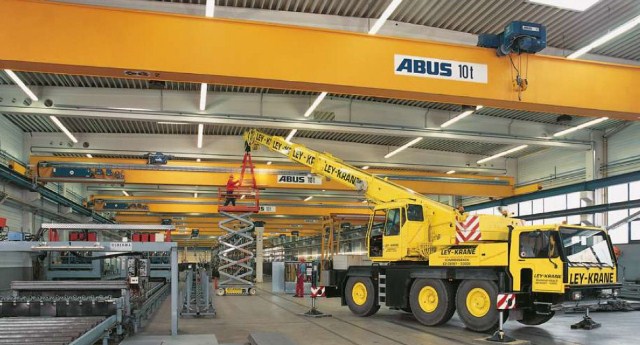
Overhead bridge crane
The main girder connection ‘version 3’ is the optimal solution for new factory buildings as this version offers the best side approach dimensions. If lifting height is the decisive factor then a single girder crane ELS with a side-running trolley is the right choice.
The single-girder traveling crane is also a good choice for special solutions: The accessories and components offer specialized additional equipment to satisfy your requirements.
Robust rolled section girders form the crane girder of the single girder traveling crane ELV whereas, traveling cranes ELK and ELS consist of torsion-resistant welded box girders.
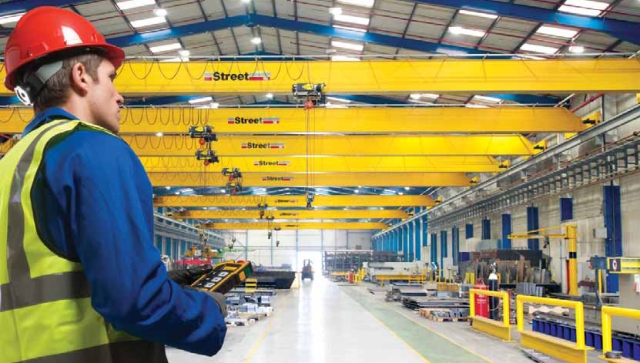
Overhead crane design
Single Girder vs. Double Girder Design
A single girder or double girder design will be one of the largest contributors to the complexity and overall cost of a new overhead crane system.
A bridge crane is a type of overhead crane that includes two or more overhead runways built into the building’s support structure. Bridge cranes have different configurations and can be comprised of one or two beams—more often referred to as a single girder or double girder design. Girders can be made of rolled steel or can be fabricated by welding the beams into a steel box design for added strength and rigidity.
Overhead travelling crane design
The bridge is a load-bearing beam that runs the width of the crane bay and is the primary structural component that connects the runways and moves the hoist forward and backward using a trolley.
The trolley and hoist can be designed to be top running or under running depending on the design of the building structure and the requirements needed to make the lift.
A single girder or double girder design will be one of the largest contributors to the complexity and overall cost of a new overhead crane system. In this article, we’ll discuss the advantages, disadvantages, and differences between single girder and double girder bridge crane systems.
You’ll want to give careful consideration to the bridge design of your overhead crane system to make sure that you understand the requirements of the lifting task and the environment where the crane will be operating.
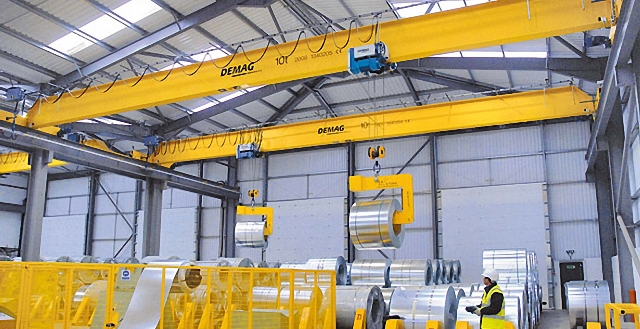
Single girder overhead travelling crane
On a single girder crane, the bridge consists of one girder beam supported on each side by an end truck. The trolley and hoist are most commonly underhung—meaning they run on the bottom flange of the bridge. The bridge itself can either be top running or under running in design.
One of the most common misconceptions about single girder cranes is that they are not as durable or of the same high quality as double girder cranes. If properly designed, a single girder crane can be the perfect solution for a business that needs a light to medium duty crane, or for a facility where headroom and/or floor space is limited.
- Single girder bridge cranes are often the most cost-effective lifting solution for various applications and industries.
- Single girder cranes use less material and are more compact and lightweight than a double girder crane, which results in a significant cost-savings in material, freight, and installation.
- Also, because they only require one bridge beam, these systems typically have less dead weight, meaning they can utilize lighter runway systems and tie into the existing building support structure.
The major disadvantage of a single girder crane system is that they do have a limit in terms of capacity, span, and hook height. A double girder crane may be the better solution for overhead cranes that require capacities over 15 tons and spans over 65 feet.
In addition, service walkways, enclosed or exposed operator cabs, magnet cable reels, or other specialized features can be difficult or expensive to incorporate into the crane’s design.

Single Girder Crane Design
Advantages of a Single Girder Design:
- Less expensive due to a simpler trolley design, reduced freight costs, simplified and faster installation, and less material for the bridge and runway beams
- A most economical option for light to medium-duty cranes
- Lower loads on the building structure or foundations due to a reduced deadweight. In many cases, it can be supported by the existing roof structure without the use of additional support columns.
- Better hook approach for both trolley travel and bridge travel
- Easier to install, service, and maintain
- Ideal for workshops, warehouses, material yards, and manufacturing and production facilities
- Lighter load on runway rails or beams means less wear on the beams and end truck wheels over time
- Great for facilities with low headroom
Disadvantages of a Single Girder Design:
- The hoist is placed under the cross girder and cannot provide as much hook height as a double girder crane
- On a standard rolled steel bridge beam, the under running hoist trolley may cause premature wear to the bottom flange of the beam
- Special features like service walks, lights, and heavy service components can be expensive or difficult to incorporate
- Lower capacity rating
Double girder overhead crane
On a double girder crane, there are two girder beams that make up the bridge and they’re supported by an end truck on each side. In most instances, the trolley and hoist run on a rail installed on top of the bridge girders. With a double girder design, you gain the depth of the cross girder if the hoist is placed between or on top of the cross girders—providing an extra 18”-36” of hook height in most cases.
Double girder cranes can be either top running or under running in design. A top running double girder bridge crane will provide the most overhead room, as well as the greatest hook height.

Double girder overhead crane specification
Double girder cranes are recommended for heavy-duty applications where the crane has to handle heavier capacities and longer spans. Because of this, the components of the crane system, including the hoist and trolley, are more complex in design—making double girder cranes more expensive than a single girder crane.
They also require more material for the bridge beams and the runway system, so extra consideration should be given to the building’s support structure. Additional tie-backs or support columns may need to be added to handle the additional deadweight on the supports or building foundation.
Double girder bridge cranes are ideal for lifting heavy loads and can be used in more frequent operation than a single girder crane. They can also be used both indoors and outdoors, in a bridge or gantry set up, and are frequently used in mining, iron and steel production, railyards, and shipping ports.
Double girder overhead crane design
Advantages of a Double Girder Design:
- Greater hook height – how far above the floor the hoist will lift (typically 18-36” more than single girder)
- No limits to maximum span or capacity
- Ideal for production and transportation of heavy equipment
- Ideal for the frequent lifting of heavy loads
- Added features like walkways and maintenance platforms, cabs, magnetic reels, and lights can be added and supported by a double girder design
- Can be used in indoor and outdoor applications, including mining, iron and steel, railyards, and ports
Disadvantages of a Double Girder Design:
- More expensive because of added material costs, additional structural support, and more complex crane components
- Additional costs related to freight and the installation of the crane versus a single girder crane
- Hook approach is lessened for both trolley travel and bridge travel especially on double girder top running cranes
Overhead crane components
Bridge crane
The main traveling structure of the crane which spans the width of the bay. The bridge consists of two end trucks and one or two bridge girders depending on the equipment type.
End trucks
Located on either side of the span, the end trucks house the wheels on which the entire crane travels. These wheels ride on the runway beam allowing access to the entire length of the bay.
Bridge Girder
The principal horizontal beam of the crane bridge which supports the trolley and is supported by the end trucks.
Trolley Hoist
The unit consisting of both the hoist and the trolley frame. In situations where more than one hoist is required on one crane, both hoists can be supplied on a single trolley or on separate trolleys.
Trolley
The trolley carries the hoist across the bay along the bridge girder(s) traversing the span.
Hoist
The hoist is mounted to the trolley and performs the actual lifting function via a hook or lifting attachment. There are two basic types of hoist. The Munck brand is a Wire Rope Hoist which is very durable and will provide long term, reliable usage. The other type of hoist is Chain Hoist.
Why buy an overhead crane?
When you purchase an overhead crane, you also benefit from our complete project management experience. This not only covers design and manufacture, but also delivery, installation, load testing, and final commissioning.
A gantry crane is slightly different from a bridge crane. The general premise is the same, but the operation is different. Some gantry cranes ride along a track installed on the floor or use a V-groove caster to keep moving in a straight line. Gantry cranes are usually less expensive than an overhead bridge crane.
The average pay for an Overhead Crane Operator is $59,000 a year and $28 an hour in the United States. The average salary range for an Overhead Crane Operator is between $42,500 and $72,250.
The Bureau of Labor Statistics reports that the average annual income of crane and tower crane operators was $50,000 on May 2012. This annual income figure is based on an average wage of $24.00 an hour and 2,050 hours of work per year.
While workers face many dangers on construction sites, crane operators are often at risk for catastrophic injuries. While crane accidents aren’t always caused by negligence, more often than not, they are preventable.
The most read

Overhead Cranes
- What are the parts of an overhead crane?
- What is the purpose of an overhead crane?
- How much does an overhead crane cost?
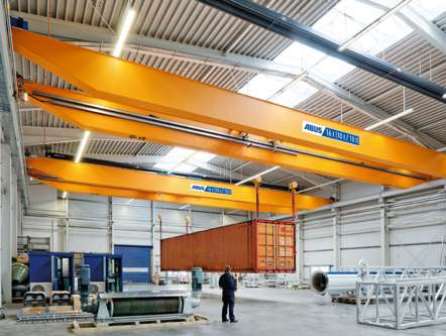
Overhead Crane Test Questions and Answers
- Crane operator interview questions and answers
- Rigging test questions and answers
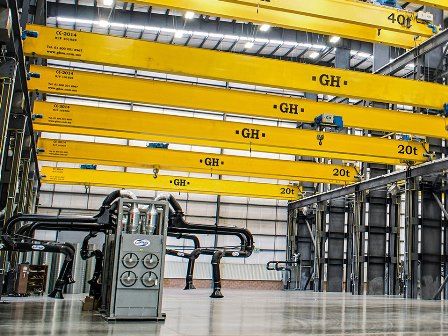
Overhead crane manufacturers in the USA
Some have wondered if in the United States they fix, manufacture, elaborate parts, and components of overhead cranes.
